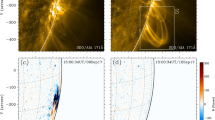Abstract
We measure geometric and physical parameters oftransverse oscillations in 26 coronal loops, out of the 17 events described in Paper I by Schrijver, Aschwanden, and Title (2002). These events, lasting from 7 to 90 min, have been recorded with the Transition Region and Coronal Explorer (TRACE) in the 171 and 195 Å wavelength bands with a characteristic angular resolution of 1", with time cadences of 15–75 seconds. We estimate the unprojected loop (half) length L and orientation of the loop plane, based on a best-fit of a circular geometry. Then we measure the amplitude A(t) of transverse oscillations at the loop position with the largest amplitude. We decompose the time series of the transverse loop motion into an oscillating component A osc(t) and a slowly-varying trend A trend(t). We find oscillation periods in the range of P=2–33 min, transverse amplitudes of A=100–8800 km, loop half lengths of L=37 000–291 000 km, and decay times of t d=3.2–21 min. We estimate a lower limit of the loop densities to be in the range of n loop=0.13–1.7×109 cm−3. The oscillations show (1) strong deviations from periodic pulses, (2) spatially asymmetric oscillation amplitudes along the loops, and (3) nonlinear transverse motions of the centroid of the oscillation amplitude. From these properties we conclude that most of the oscillating loops do not fit the simple model of kink eigen-mode oscillations, but rather manifest flare-induced impulsively generated MHD waves, which propagate forth and back in the loops and decay quickly by wave leakage or damping. In contrast to earlier work we find that the observed damping times are compatible with estimates of wave leakage through the footpoints, for chromospheric density scale heights of ≈400–2400 km. We conclude that transverse oscillations are most likely excited in loops that (1) are located near magnetic nullpoints or separator lines, and (2) are hit by a sufficiently fast exciter. These two conditions may explain the relative rarity of detected loop oscillations. We show that coronal seismology based on measurements of oscillating loop properties is challenging due to the uncertainties in estimating various loop parameters. We find that a more accurate determination of loop densities and magnetic fields, as well as advanced numerical modeling of oscillating loops, are necessary conditions for true coronal seismology.
Similar content being viewed by others
References
Aschwanden, M. J. and Acton, L. W.: 2001, Astrophys. J. 550, 475.
Aschwanden, M. J., Newmark, J. S., Delaboudinière, J. P., Neupert, W. M., Klimchuk, J. A., Gary, G. A., Portier-Fornazzi, F., and Zucker, A.: 1999a, Astrophys. J. 515, 842.
Aschwanden, M. J., Fletcher, L., Schrijver, C., and Alexander, D.: 1999b, Astrophys. J. 520, 880.
Aschwanden, M. J., Alexander, D., Hurlburt, N., Newmark, J. S., Neupert, W. M., Klimchuk, J. A., and Gary, G. A.: 2000, Astrophys. J. 531, 1129.
Berghmans, D. and DeBruyne, P.: 1995, Astrophys. J. 453, 495.
Davila, J. M.: 1991, in P. Ulmschneider, E. R. Priest, and R. Rosner (eds.), Mechanisms of Chromospheric and Coronal Heating, Springer-Verlag, Berlin, p. 464.
De Pontieu, B., Martens, P., and Hudson, H.: 2001, Astrophys. J. 558, 859.
Dulk, G. A. and McLean, D. J.: 1978, Solar Phys. 57, 279.
Gary, G. A.: 1989, Astrophys. J. Suppl. 69, 323.
Gary, G. A. and Alexander, D.: 1999, Solar Phys. 186, 123.
Hollweg, J. V.: 1984, Astrophys. J. 277, 392.
Hudson, H. S. and Kosugi, T.: 1999, Science 285, 894.
Johannesson, A. and Zirin, H.: 1996, Astrophys. J. 471, 510.
Lee, J. W., White, S. M., Kundu, M. R., Mikic, Z., and McClymont, A. N.: 1999, Astrophys. J. 510, 413.
Murawski, K. and Roberts, B.: 1993a, Solar Phys. 143, 89.
Murawski, K. and Roberts, B.: 1993b, Solar Phys. 144, 101.
Murawski, K. and Roberts, B.: 1993c, Solar Phys. 144, 255.
Murawski, K. and Roberts, B.: 1993d, Solar Phys. 145, 65.
Murawski, K. and Roberts, B.: 1994, Solar Phys. 151, 305.
Nakariakov, V. M. and Ofman, L.: 2001, Astron. Astrophys. 372, L53.
Nakariakov, V. M., Ofman, L., DeLuca, E., Roberts, B., and Davila, J. M.: 1999, Science 285, 862.
Ofman, L.: 2002, Astrophys. J. Letters, submitted.
Pekeris, C. L.: 1948, Geol. Soc. Amer. Mem. 27, 117.
Roberts, B.: 1986, in A. I. Poland (ed.), Coronal and Prominence Plasmas, NASA Conf. Publ. 2442, p. 325.
Roberts, B.: 2000, Solar Phys. 193, 139.
Roberts, B., Edwin, P. M., and Benz, A. O.: 1984, Astrophys. J. 279, 857.
Schrijver, C. J. and Brown, D. S.: 2000, Astron. Astrophys. 537, L69.
Schrijver, C. J., Aschwanden, M. J., and Title, A.: 2002, Solar Phys. 206, 69 (this issue) (Paper I).
Warren, H. P., Bookbinder, J. A., Forbes, T. G., Golub, L., Hudson, H. S., Reeves, K., and Warshall, A.: 1999, Astrophys. J. 527, L121.
Author information
Authors and Affiliations
Electronic supplementary material
Rights and permissions
About this article
Cite this article
Aschwanden, M.J., De Pontieu, B., Schrijver, C.J. et al. Transverse Oscillations in Coronal Loops Observed with TRACE – II. Measurements of Geometric and Physical Parameters. Sol Phys 206, 99–132 (2002). https://doi.org/10.1023/A:1014916701283
Issue Date:
DOI: https://doi.org/10.1023/A:1014916701283




